La numérisation de la broderie est une forme d'art qualifiée qui joue un rôle crucial dans la transformation de beaux motifs en motifs brodés complexes.. Que vous soyez un aspirant numériseur de broderie ou que vous cherchiez à perfectionner vos compétences existantes, maîtriser le métier nécessite plus qu’une simple compétence technique.
Cet article présente cinq conseils éprouvés pour réussir en tant que numériseur de broderie..
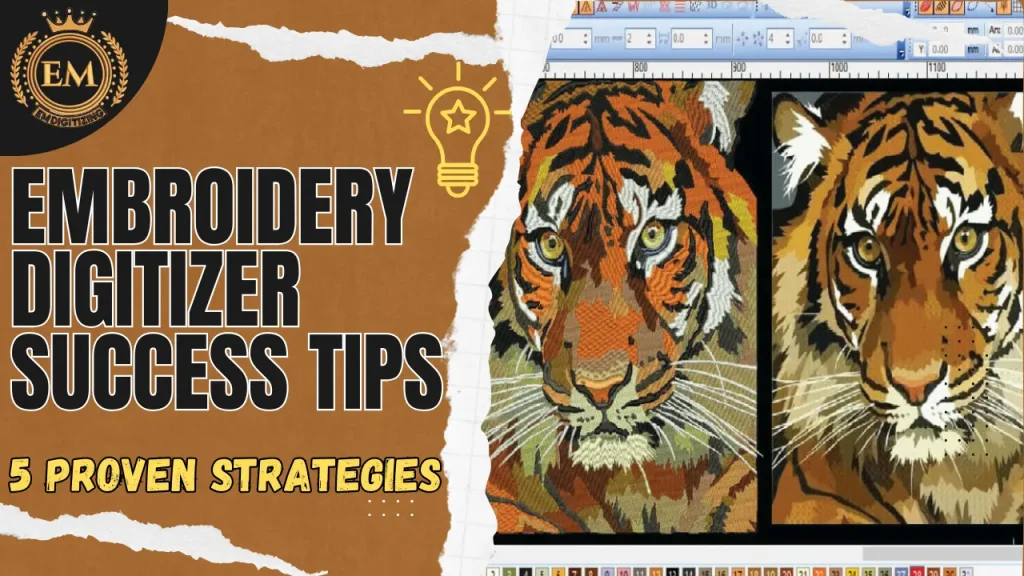
Alors$£€¥789/456*123-0.=+_çàiopjkln,;:! ذ ضِ ئ, let’;Plongez dans ces conseils clés pour le numériseur de broderie et découvrez les secrets pour devenir un numériseur de broderie compétent et le meilleur..
Numériseurs de broderie jouent un rôle crucial dans la transformation de beaux motifs en superbes chefs-d'œuvre brodés..
Mais à quoi sert exactement un numériseur de broderie ??
Let’;découvrez!
Conseils pour réussir le numériseur de broderie: 5 Stratégies éprouvées
À quoi sert un numériseur de broderie?
Un numériseur de broderie qualifié prend un dessin, whether it’;c'est un logo, ouvrages d'art, ou une création sur mesure, et le convertit en fichier numérique qu'une machine à broder peut lire.
Ils traduisent les détails complexes, couleurs, et ombrage d'un motif dans les commandes de point, en veillant à ce que la pièce brodée finale soit aussi proche que possible de l'original.
Compétences et connaissances clés requises
Le premier conseil pour réussir avec un numériseur de broderie est que vous devez avoir une solide compréhension des principes de conception et des aspects techniques.. Vous devez bien connaître diverses techniques de broderie, et théorie des couleurs, et avoir un sens aigu du détail.
En outre, une bonne connaissance de machines à broder et les logiciels sont essentiels pour donner vie aux conceptions.
Importance de la précision et du souci du détail
L’attention aux détails est primordiale dans la numérisation de broderies de qualité. Une petite erreur dans un dessin numérisé peut entraîner un défaut important dans la pièce brodée finale. Précision dans la recréation des couleurs, formes, and textures is crucial to ensure the design’;l'intégrité.

Maîtriser l’art de la conversion du design
Conversion de fichiers de conception en formats de broderie est un art en soi. Let’;Découvrez quelques conseils de réussite en matière de numérisation de broderie pour vous aider à exceller dans cet aspect de la numérisation de la broderie..
Conversion de fichiers de conception en formats de broderie
La maîtrise du processus de conversion passe par la sélection du format de fichier approprié pour broder. Comprendre les capacités et les limites des différents broderie Logiciel et les machines vous aideront à faire des choix éclairés.

Expérimenter différents formats et exécuter des points de test peut garantir que le résultat final correspond à votre vision..
Gérer des conceptions complexes et des variations de couleurs
Les conceptions complexes et les variations de couleurs complexes peuvent poser des défis lors de la numérisation.. Décomposer le design en sections gérables et prêter une attention particulière aux changements de couleur peut rendre le processus plus fluide..
Expérimenter différents types et densités de points peut aider à obtenir la texture et l'apparence souhaitées..
Optimisation de la taille et du placement de la conception
La taille et l'emplacement sont des facteurs cruciaux à prendre en compte lors de la numérisation d'un design. Il est essentiel de s'assurer que le motif s'adapte correctement à la zone de broderie souhaitée et complète le vêtement ou le tissu..
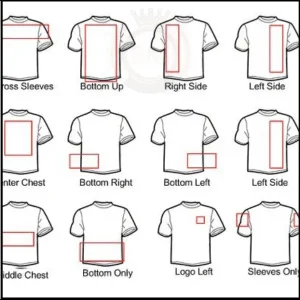
Experimenting with different sizes and orientations can help optimize the design’;s impact visuel et éviter la distorsion pendant le processus de couture.
Utiliser les bons outils et logiciels
S'équiper de les bons outils et les logiciels peuvent améliorer considérablement vos compétences en matière de numérisation de broderie. Let’;Découvrez quelques conseils pour réussir avec un numériseur de broderie.
Logiciel essentiel de numérisation de broderie
Investir dans un logiciel de numérisation de broderie de haute qualité change la donne. Recherchez un logiciel offrant une gamme complète d’outils d’édition de conception, simulation de point précise, et compatibilité avec différents formats de machines à broder.

Les options logicielles populaires incluent Wilcom, Embird, et Broderie hachurée.
Comprendre et utiliser différents outils
Dans le logiciel de votre choix, it’;Il est essentiel de se familiariser avec les différents outils de numérisation disponibles. Ces outils vous permettront de créer et de manipuler des formes, ajuster les paramètres de point, et peaufiner les détails.
Prenez le temps d’expérimenter et de maîtriser ces outils pour libérer votre potentiel digitalisant.
Explorer les fonctionnalités avancées et les plugins
Les logiciels de numérisation de broderie sont souvent dotés de fonctionnalités et de plugins avancés qui peuvent rationaliser votre flux de travail et ouvrir de nouvelles possibilités..

Explorez des options telles que la numérisation automatique, caractéristiques de lettrage, et des effets spéciaux pour ajouter une touche supplémentaire à vos créations. Don’;N'hésitez pas à essayer de nouveaux outils et techniques pour élargir vos horizons créatifs..
Perfectionner le processus de numérisation
Pour réussir la numérisation de la broderie, maîtriser le processus de numérisation lui-même est essentiel. Suivez ces conseils de réussite du numériseur de broderie pour perfectionner votre métier.
Comprendre l'anatomie d'une conception numérisée
Une conception numérisée se compose de divers composants, tel que points de sous-couche, remplir les points et points satin. Comprendre le but et les caractéristiques de chaque composant vous aidera à créer des designs parfaitement cousus..
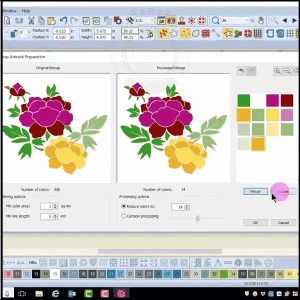
En savoir plus sur les types de points, densités, et les techniques de sous-couche vous permettront de prendre des décisions éclairées pendant le processus de numérisation.
Techniques efficaces de flux de travail et d’organisation
Établir un flux de travail efficace est essentiel pour maximiser votre productivité en tant que numériseur de broderie.
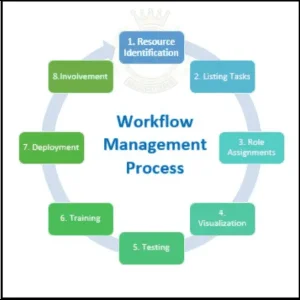
Organisez logiquement vos fichiers de conception, créer des modèles pour les éléments récurrents, et établir une approche systématique de la numérisation. Développer un flux de travail cohérent vous fera gagner du temps et réduira les risques d'erreurs.
Conseils pour réussir le numériseur de broderie pour un ordre et une densité de couture appropriés
Déterminer le bon piqûre densité et l'ordre est crucial pour obtenir des résultats de numérisation de broderie de haute qualité. Commencez par réfléchir à l'ordre dans lequel les éléments doivent être cousus pour garantir des transitions fluides et éviter les points sautés inutiles..
Expérimentez avec différentes densités de points pour obtenir le niveau de couverture souhaité tout en conservant l'intégrité du motif..
Améliorer la productivité et l'efficacité
Enhancing productivity and efficiency is crucial in today’;un monde en évolution rapide, où le temps est souvent une ressource limitée.
Stratégies de gestion du temps pour les numériseurs
En tant que numériseur de broderie, le temps est votre atout le plus précieux. Pour en profiter au maximum, mettre en œuvre des stratégies simples de gestion du temps. Hiérarchisez vos tâches et créez un calendrier qui permet un travail ciblé.
Évitez le multitâche, car cela peut entraîner des erreurs et une perte de temps. Divisez les grands projets en plus petits, tâches gérables, et fixer des délais réalistes pour chacun. Pensez à faire des pauses régulières pour recharger votre créativité et éviter le burn-out.
Utilisation de modèles et de normalisation
Les modèles et la standardisation sont vos armes secrètes pour gagner en efficacité. Créez et enregistrez des modèles de conceptions ou d'éléments couramment utilisés pour réduire le temps passé à les recréer à partir de zéro..
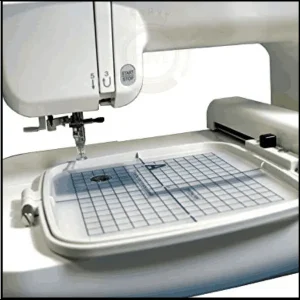
Établir des lignes directrices et des processus cohérents pour numériser différents types de conceptions, so you don’;Je n'ai pas besoin de réinventer la roue à chaque fois. Cela accélérera votre flux de travail et garantira un produit final cohérent.
Automatisation des tâches répétitives
Personne n'aime faire la même chose encore et encore, surtout les numériseurs. Recherchez des opportunités d'automatiser des tâches répétitives à l'aide d'un logiciel de broderie.
Traitement par lots, conversions automatiques de couleurs, et les outils de numérisation automatique peuvent vous faire gagner un temps et des efforts précieux.
Expérimentez différentes fonctionnalités de votre logiciel pour trouver les solutions d'automatisation qui vous conviennent le mieux. N'oubliez pas d'examiner attentivement les résultats pour maintenir le contrôle de la qualité..
Développer une communication efficace avec les clients
Développer une communication efficace avec les clients est fondamental pour bâtir une solide, des relations durables qui favorisent le succès de l'entreprise.
Comprendre les exigences et les attentes des clients
Pour livrer des conceptions numérisées exceptionnelles, you must understand your client’;s exigences et attentes. Prendre le temps de discuter des projets avec les clients et de poser des questions détaillées pour clarifier leur vision.

Faites attention à leurs préférences concernant les types de points, couleurs, et compatibilité des tissus. Mieux vous comprenez leurs besoins, plus les chances de dépasser leurs attentes sont élevées.
Établir des canaux de communication clairs et cohérents
La communication est la clé de toute relation commerciale réussie. Établissez des canaux de communication clairs et cohérents avec vos clients. Whether it’;s par e-mail, appels téléphoniques, ou un outil de gestion de projet, assurez-vous que tout le monde est sur la même longueur d'onde.
Répondre rapidement aux demandes des clients et fournir des mises à jour régulières sur l'avancement de leurs projets. Une communication claire renforce la confiance et favorise les relations clients à long terme.
Naviguer dans les commentaires et les révisions des clients
Les commentaires et révisions des clients font partie du processus de numérisation. Considérez-les comme des opportunités d’améliorer votre travail. Lors de la réception de commentaires, écouter attentivement et demander des éclaircissements si nécessaire.

Don’;je ne le prends pas personnellement; au lieu, utilisez-le comme une opportunité d'affiner vos créations. Soyez ouvert aux révisions et démontrez votre engagement à fournir le meilleur résultat final possible. Une approche positive et collaborative du feedback impressionnera vos clients.
Maintenir le contrôle qualité et le dépannage
Le maintien du contrôle qualité et le dépannage sont des éléments essentiels pour garantir la livraison de produits et de services qui répondent ou dépassent les attentes des clients..
Garantir la précision et l’intégrité de la conception
Le contrôle qualité est crucial pour le succès de votre numérisation de broderie. Vérifiez toujours l’exactitude et l’intégrité de vos conceptions avant de les envoyer aux clients. Faites attention aux détails comme le nombre de points, alignement, et des transitions fluides.
Testez la conception sur différents tissus et machines pour garantir une compatibilité et des résultats optimaux. En fournissant des conceptions numérisées de haute qualité, you’;je vais établir une réputation d’excellence.
Identifier et résoudre les problèmes courants liés à la numérisation
Même les numériseurs les plus expérimentés rencontrent de temps en temps des problèmes courants.. Restez vigilant et soyez proactif dans l’identification et la résolution de ces problèmes. Le fil casse, formes déformées, et des textes mal numérisés ne sont que quelques exemples.
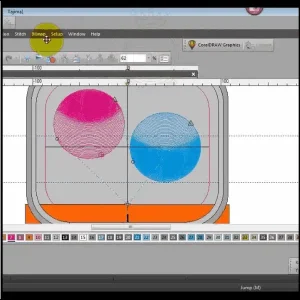
Research and learn from other digitizers’; expériences, et chercher des solutions pour surmonter ces défis. Les compétences en dépannage sont essentielles pour maintenir la qualité et fournir des conceptions impeccables.
Effectuer des contrôles d’assurance qualité
Pour garantir une qualité constante, effectuer des contrôles d'assurance qualité réguliers tout au long du processus de numérisation. Examinez méticuleusement chaque conception, prêter attention aux détails comme les couleurs des fils, densité, et coutures de sous-couche.
Compare the final output to the client’;s exigences pour assurer l’alignement. Don’;N'ayez pas peur de faire des ajustements et de retester la conception jusqu'à ce qu'elle réponde à vos normes élevées. Un processus d’assurance qualité approfondi garantit la satisfaction du client.
Conclusion
Rappelles toi, la numérisation de la broderie est à la fois un art et une compétence. Adoptez ces conseils de réussite pour le numériseur de broderie, adaptez-les à votre flux de travail, et profitez du voyage pour devenir un numériseur de broderie à succès. Votre passion et votre dévouement transparaîtront dans chaque point.
Bonne numérisation!
EMnumérisation: Expert en numérisation de broderie à votre service
Si vous êtes intéressé par tout type de projet de broderie, alors EMdigitizing est la meilleure option pour vous. Nous offrons numérisation de broderie et des services d'art vectoriel avec un délai d'exécution rapide. Vous pouvez également visiter et consulter notre site Web ainsi que nos meilleurs services.
Nous offrons également un excellent 50% réduction sur tous nos services pour nos nouveaux clients respectés. Nous proposons également devis gratuits généré en seulement 5 minutes.
Vous devriez profiter de cette offre à durée limitée et faire passer votre projet de broderie au niveau supérieur avec EMdigitizing.
Si vous avez des questions concernant ce sujet, tu peux leur demander. Merci d'avoir pris le temps de lire cet article.
Questions fréquemment posées:
Pour commencer à numériser la broderie, you’;Je devrai apprendre les bases d'un logiciel de broderie, comprendre les différents types de points, et entraînez-vous à convertir des images en fichiers de points. Commencez avec des versions gratuites ou d'essai du logiciel de numérisation et suivez des didacticiels en ligne ou suivez des cours pour développer vos compétences..
Devenir numériseur professionnel nécessite de maîtriser un logiciel de numérisation de broderie, comprendre les types de tissus et les points appropriés, et acquérir de l'expérience par la pratique et le feedback. Envisagez d'obtenir une certification auprès d'organisations réputées et d'apprendre continuellement de nouvelles techniques et tendances du secteur..
Les revenus des numériseurs peuvent varier considérablement en fonction de l'expérience, lieu, et l'industrie dans laquelle ils travaillent. En moyenne, les numériseurs de broderie peuvent gagner n'importe où $30,000 à $60,000 par année, avec des professionnels expérimentés gagnant éventuellement plus.
Apprendre à numériser la broderie peut s'avérer difficile en raison de la complexité du logiciel et de la nécessité de comprendre le comportement des points sur différents tissus.. Cependant, avec dévouement, entraine toi, et les bonnes ressources, la plupart des gens peuvent acquérir les compétences nécessaires pour créer des motifs de broderie de haute qualité.
